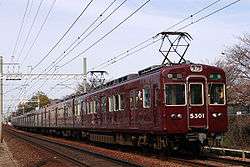Kandai-mae Station
Kandai-mae Station (関大前駅, Kandai-mae-eki) is a train station on the Hankyu Railway Senri Line located in Suita, Osaka Prefecture, Japan.
Kandai-mae Station 関大前駅 | |
|---|---|
_IMG_5248r_20160807.jpg) | |
| Location | 1, Senriyama-higashi, Suita, Osaka (大阪府吹田市千里山東1) Japan |
| Coordinates | 34°46′16″N 135°30′21″E |
| Operated by | Hankyu Corporation |
| Line(s) | Senri Line |
| Connections | |
| History | |
| Opened | 1964 |
Layout
- There are two side platforms with two tracks on the ground level.
| west side | ■ Senri Line | for Kita-Senri |
| east side | ■ Senri Line | for Umeda, Tenjimbashisuji Rokuchome, Tengachaya, Kyoto, Kobe and Takarazuka |
History

Hankyu Railway
- October 26, 1921 – Kadan-mae Station (花壇前駅) on Kita-Osaka Railway was opened.
- April 17, 1922 – Daigaku-mae Station (大学前駅) was opened between Kadan-mae Station and Senriyama Station.
- April 1, 1923 – Kadan-mae Station and Daigaku-mae Station became stations on Shin-Keihan Railway.
- September 15, 1930 – Kadan-mae Station and Daigaku-mae Station became stations on the Keihan Railway (old) Senriyama Line.
- September 15, 1938 – Kadan-mae Station was renamed Senriyama-yūen Station (千里山遊園駅).
- October 1, 1943 – Hanshin Kyuko Railway Company consolidated Keihan Railway Company (old) and was renamed Keihanshin Kyuko Railway Company, thus Kadan-mae Station and Daigaku-mae Station became stations on the Keihanshin Kyuko Railway Senriyama Line.
- December 1, 1943 – Senriyama-yūen Station was renamed Senriyama-kōseien Station (千里山厚生園駅).
- April 7, 1946 – Senriyama-kōseien Station was renamed Senriyama-yūen Station (千里山遊園駅) again.
- August 1, 1950 – Senriyama-yūen Station was renamed Jogakuin-mae Station (女学院前駅).
- April 1, 1951 – Jogakuin-mae Station was renamed Kadanchō Station (花壇町駅).
- April 10, 1964 – Kadanchō Station and Daigaku-mae Station were united and Kandai-mae Station (関大前駅) was opened.
- March 1, 1967 – The Senriyama Line was renamed the Senri Line.
Surrounding
- Kansai University Senriyama Campus
Stations next to Kandai-mae
| « | Service | » | ||
|---|---|---|---|---|
| Hankyu Senri Line | ||||
| Toyotsu | Local | Senriyama | ||
gollark: Android does in fact use Java for all things.
gollark: I mean, I agree, but I try and avoid particularly bad ones.
gollark: And yet you USE IT?!?!?!
gollark: Windows is *actually* to be subject to a vast number of bees.
gollark: https://news.ycombinator.com/item?id=26273502
This article is issued from Wikipedia. The text is licensed under Creative Commons - Attribution - Sharealike. Additional terms may apply for the media files.